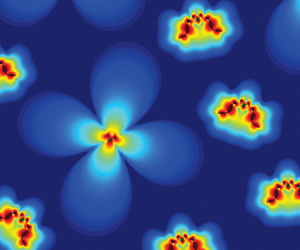Article contents
Active cloaking in Stokes flows via reinforcement learning
Published online by Cambridge University Press: 30 September 2020
Abstract

Hydrodynamic signatures at the Stokes regime, pertinent to motility of micro-swimmers, have a long-range nature. This implies that movements of an object in such a viscosity-dominated regime can be felt tens of body-lengths away and significantly alter dynamics of the surrounding environment. Here, we devise a systematic methodology to actively cloak swimming objects within any arbitrarily crowded suspension of micro-swimmers. Specifically, our approach is to conceal the target swimmer throughout its motion using cooperative flocks of swimming agents equipped with adaptive decision-making intelligence. Through a reinforcement learning algorithm, the cloaking agents experientially learn an optimal adaptive behaviour policy in the presence of flow-mediated interactions. This artificial intelligence enables them to dynamically adjust their swimming actions, so as to optimally form and robustly retain any desired arrangement around the moving object without disturbing it from its original path. Therefore, the presented active cloaking approach not only is robust against disturbances, but also is non-invasive to motion of the cloaked object. We then further generalize the proposed approach and demonstrate how our cloaking agents can be readily used, in any region of interest, to realize hydrodynamic invisibility cloaks around any number of arbitrary intruders.
- Type
- JFM Papers
- Information
- Copyright
- © The Author(s), 2020. Published by Cambridge University Press
References
REFERENCES
Mirzakhanloo et al. Supplementary Movie
(a) Time evolution of a crowded suspension of intruders (shown in green), each of which actively cloaked by a pair of smart micro-swimmers (cloaking agents shown in blue). Here the intruders are freely moving toward arbitrary directions in space. Periodic boundary conditions are imposed on the presented panel -- i.e. it represents just a window of an infinite domain. As evident in the system's time evolution, using their adaptive decision-making intelligence, our agents are able to robustly maintain the cloak formation in the presence of complex hydrodynamic interactions. They are also able to immediately restore the desired formation after any sever close encounters which cause major disruptions to the cloak. (b) Magnitude of the disturbing flows (i.e. flow signatures) induced by the actively cloaked system, monitored throughout the presented time evolution.
- 15
- Cited by



